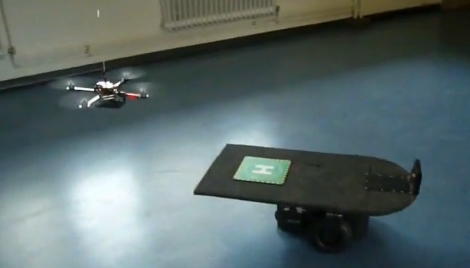
[Karl-Engelbert Wenzel] developed a UAV capable of taking off and landing on a moving platform autonomously. The platform operates aircraft-carrier-style by driving around the room in circles. The quadcopter tracks a grid of IR LEDs at the front of the landing deck by using the IR camera from a Wii remote. The best part is that the flight controls and processing are all done by the copter’s onboard ATmega644 processor, not requiring a connection to a PC. The landings are quite accurate, achieving a maximum error of less than 40 centimeters. In the video after the break you can see the first landing is slightly off the mark but the next two are dead on target.
So build yourself a mobile platform and pair it up with your newly finished quadcopter to replicate this delightful hack.
[youtube=http://www.youtube.com/watch?v=XpUdW_U2KJ8]















hell yeah. that is very awesome. easy docking station idea: one of those wireless charging pads. put the battery or at least the connections on the bottom and the other half paint like the landing strip. viola. :)
Some outdoor tests me thinks, works exceptionally well, i cant even land an RC heli on target!
Now all left to do is make a biger quadcopter to land on
Impressive work! I bet the military is interested in stuff like this.
Combine this with gps so one can track the other.
If the UAV is low on energy the carrier will come to it’s rescue and if the carrier is low the UAV will try to approach instead.
It makes more noise than i expected. Replace the blades with fans.
Very nice!
And so it was in the first years of the 21st century…skynets roots were born. 10 years later, the world was taken by these autonomous death machines. ;)
Very, very cool! I like that! I was thinking of making a similar thing in fact.
One thing I would say is that the UAV seemed a little ‘wobbly’ for my likings. Perhaps the PID gains could be tuned better, but I’m sure you could get better performance from that thing.
But nonetheless, very fun.
hehe.
I was watching terminator salvation this morning.
Love the project though. Agreed about not being able to land an RC heli on target!
With GPS it would be great, autonomous landing from a few miles away. IR when it got in range.
Mowcius
wouldn’t 40cm error miss the thing entirely?
Larry Niven’s “Copseye” just got a little bit closer to deployment.
http://www.technovelgy.com/ct/content.asp?Bnum=309
Is the error cm or mm? The first landing looks much closer than 60cm, and the 2nd is really close – not 10cm…
Yeah, looks like they labeled this incorrectly. Either that or the room is 10 times as large as it looks.
Nice to see a homebrew hack with some immediately apparent real-world applications.
The distances in the movie seem fishy to me, too. And the room is definitely not *that* huge. We tested the robots for RoboCup there, back when the team was still active. Nice to see that the robots are getting re-used as aircraft-carriers :-)
this is grrrreat!
Land that thing on a Humvee at 60mpg and the military will buy 1 million of them.
MPH*
Hi,
I’m the developer.
First of all I want to thank you for all your comments :)
Just to clarify some issues:
The landing place is 60cm away from the pattern, thats why it says 60cm distance.
During landing, the max. error was in fact around 10cm…
The maximum of 40cm error is during tracking, so it does not affect the landing. But I have to concede that not all of the experiments succeeded. 90% success rate.
@guffguu:
You’re right, the PID controllers could be more precisely, but it was hard to find parameters, which allow the errors, forced by the platform and are precisely the same time…
@ Oren Beck: +5 points awarded for directly referencing Larry Niven.
Resume play
I have wheeled ROV that would benefit from an “eye in the sky” to help with navigation and general overall killerness…ness.
That’s simply outstanding work right there.
yes charger on the dock would rule. -inductive perhaps?
Hey, it strikes me that you might be able to pick up a busted Palm Pre and grab the touchstone kit for it kinda cheap nowadays.
Using an inducting charger like the touchstone kit is a great idea. But the LiPo batteries usually are charged with a balancer, so I thought of attaching pads below each rotor to charge every single cell for its own…
You wouldn’t need to buy a busted pre, you can buy the touchstone and the battery cover seperately from the phone.
This would be sweet with those desert autonomous races. Think of it, vehicle leaves base, finds safe spot and pauses, heli takes off, vehicle proceeds, heli maps out future terrain, comes back, vehicle pauses, heli lands, vehicle gets mapped data, possibly quicker?
we used a system similar to this in the navy, but using radio signals instead of lights. the aircraft side was called acls (automated carrier landing system), and the shipboard component was called the spin 41 (spn-41a). the radio signal was interpreted as a + shaped display with lights to tell the pilot to ascend/descend/bear left or right, and “on-the-ball.”
A derivative control system is required to enable smooth tracking and landing. Sense you utilized an aircraft carrier then additional axis are needed such as Z and yaw. No problem if the derivative control system is adjusted properly. I suggest making the speed of the propellers inversely proportional to the distance from the deck taking into consideration stall factors and maneuverability of the air craft.